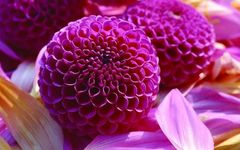Summary of TCM Courses
01
All Courses by Ni Haixia
02
Comprehensive TCM Treatments for Common Diseases
03
Focused Learning on TCM Topics
04
Online Reading of TCM Learning Books
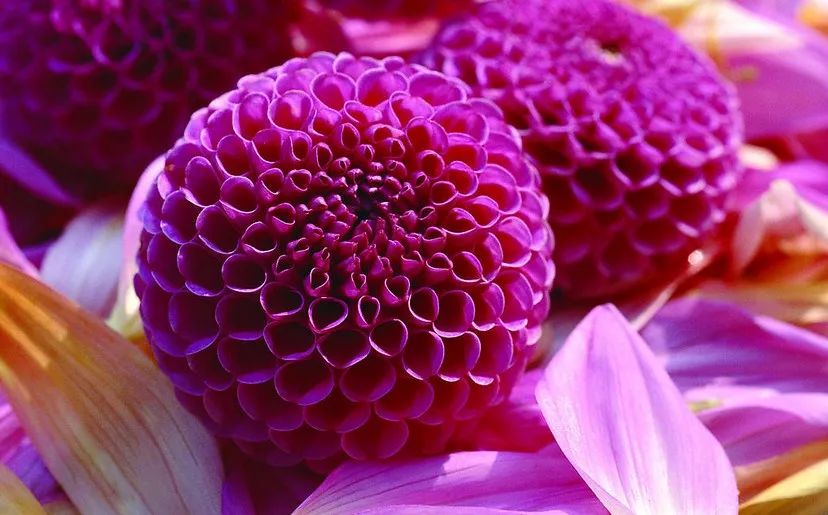
Listen to TCM for Better Health

Source of Audio: Hanhai Yixue
Unlike other brilliant civilizations that have been sealed in historical museums, Traditional Chinese Medicine (TCM) has largely maintained its original form, evolving from over 2000 years ago to the present. History is impartial and harsh; it does not favor TCM. Its survival is primarily due to the scientific nature, strong vitality, and practical value of TCM itself.
TCM views the natural, biological, psychological, and social attributes of humans as a unified whole to understand the life process, physiology, pathology, disease diagnosis, and health preservation. It has formed a treatment method centered on syndrome differentiation (bianzheng lunzhi), which is a unique traditional medical science in China. The theoretical and diagnostic systems of TCM are founded and developed in the Huangdi Neijing (The Yellow Emperor’s Classic of Medicine). The Neijing is divided into two parts: Suwen (Plain Questions) and Lingshu (Spiritual Pivot), each containing 81 chapters, completed over a period of six to seven hundred years from the Warring States to the Eastern Han Dynasty by multiple physicians. It is the earliest existing encyclopedic ancient medical text in China. The guiding ideology of the Neijing is the holistic dynamic view, which sees humans and the natural world as a unified whole that continuously changes with the passage of time and space. Heaven and Earth are a unified whole. In the Suwen, it states: “Heaven and Earth are the up and down of all things.” This means that above us is Heaven, and below us is Earth, referring broadly to the natural world we inhabit. It is believed that the movement and changes of the six qi (wind, heat, fire, dampness, dryness, cold) form the seasons of spring, summer, long summer, autumn, and winter, giving rise to all things and life on Earth. These life phenomena undergo the processes of “birth, growth, transformation, harvest, and storage” or “birth, growth, maturity, aging, and death”. The human body is also a unified whole. TCM classifies the structure, functional activities, mental emotions, and natural phenomena of the human body extensively, emphasizing that the five organs (liver, heart, spleen, lung, kidney) are a unified whole. Therefore, when facing a disease, we must consider not only which organ is problematic but also the interrelationships between this organ and others. “The five organs are interconnected, and each has its order.” Thus, TCM does not treat symptoms in isolation but considers the overall coordination and balance. “Humans correspond with Heaven and Earth.” If the temperature exceeds 60°C, it becomes difficult for humans to survive. Therefore, Heaven and Earth are the fundamental conditions for human life. The relationship between humans and Heaven and Earth is that “humans respond to Heaven”. In the Suwen, it states: “Success and failure depend on movement; if movement does not cease, then change occurs. Without entry and exit, there is no growth and maturity; without rising and falling, there is no growth, transformation, and storage. Therefore, rising, falling, entering, and exiting are universal principles.” Ignoring this change is not feasible. For the same cold, TCM will adopt different treatment methods depending on the four seasons, examining and addressing human diseases from the perspective of dynamic changes. The theoretical foundation of the Neijing is the theory of qi transformation. The so-called “qi” refers to natural climatic conditions, specifically the six qi: wind, heat, fire, dampness, dryness, and cold. Even today, the National Meteorological Administration still publishes weather forecasts based on these six elements, albeit in a more quantified and precise manner. “The phenomena of life are called transformation,” meaning that all life phenomena on the ground are called “transformation”. Without qi, there is no transformation; “when qi stops, transformation ceases”. Through long-term observation, TCM has discovered that changes in natural climate exhibit periodicity, and diseases also follow similar cycles. In 1733, the year of Gui Chou, a major epidemic occurred in Beijing. Sixty years later, in 1793, also a Gui Chou year, another major epidemic struck Beijing. Historical records state, “In the year of Gui Chou, the plague spread widely, and the number of deaths was countless.” The Neijing records that a major epidemic occurred in the year of Gui Chou. In 2003, SARS began to spread. At that time, I consulted the Neijing, which mentioned, “In the period of Chou Wei… the second qi… the disease of warm pestilence spreads widely, both near and far.” The “second qi” refers to the period from the Spring Equinox on March 21 to the beginning of the Minor Grain in mid-May, indicating that it is not limited to one time or place but rather widespread. The Suwen states: “The natural climate also has self-stabilizing regulatory laws. When one of the six qi (wind, heat, fire, dampness, dryness, cold) is too strong, there will be a corresponding qi that can subdue it, restoring it to normal. Since ‘humans correspond with Heaven and Earth’, the human body also possesses such a self-regulatory mechanism. The starting point for TCM diagnosis and treatment of diseases is not pathogenic microorganisms. TCM believes that when the human body can adjust according to the external environment, it is healthy; when it is out of balance, it is in a pathological state. When treating with acupuncture or herbal medicine, the focus of diagnosis is not on whether bacteria or viruses have turned negative, but rather on whether the human body has restored its self-regulatory state. The laws of human life are in harmony with the laws of nature, known as ‘the great rhythm of Heaven and Earth, the correspondence between humans and the divine’. The Neijing describes the relationship between the human body and seasonal rhythms as ‘the five organs correspond to the four seasons’ and ‘the storage of qi follows the seasons’ (where ‘storage’ refers to ‘organs’). In spring, the predominant qi is wind and warmth, so liver diseases, wind diseases, and warm diseases are most common. In summer, the heat is intense, corresponding to heart qi, and at this time, the pulse is large and strong, with heart diseases and heat diseases being more prevalent. In the long summer, the humidity is high, corresponding to spleen qi, and the pulse is soft and heavy, indicating that spleen diseases and damp-heat diseases are more common, especially in gastrointestinal clinics. In autumn, the predominant qi is dryness, corresponding to lung qi, and during this time, the pulse is floating, making it a high season for respiratory diseases. In winter, the cold is severe, corresponding to kidney qi, and the pulse is heavy. During this time, kidney diseases and cold diseases are more common, as well as bone and joint diseases. The daily rhythm also has a certain impact on humans. “At dawn, human qi is born; at noon, yang qi is abundant; in the evening, yang qi is depleted, and the qi gates close” (Suwen, Theory of Vitality). From 11 PM to 3 AM is the lowest point of yang qi and the peak of yin qi, and most patients pass away during the deep night. There are also temporal rhythms, where the flow of qi and blood is related to time, known as “the flow of qi at the time of Zi and Wu, the eight methods of the spirit turtle”. The theory of qi transformation is the foundation of TCM theory. The etiology theory posits that abnormal changes in the six qi are the causes of exogenous diseases; the pathogenesis theory understands the nature of diseases through changes in the six qi. “All wind dizziness belongs to the liver. All cold retraction belongs to the kidney. All qi stagnation belongs to the lung. All dampness and fullness belong to the spleen… All pain, itching, and sores belong to the heart.” The treatment principles emphasize adapting to time, place, and person. “When the righteous qi is preserved internally, evil cannot invade.” “Wherever evil gathers, its qi must be deficient.” “Carefully observe the location of yin and yang and adjust them, aiming for balance.” The theory of formulas and medicines involves the monarch, minister, assistant, and envoy of formulas, as well as the properties and meridian pathways of herbs; the theory of health preservation emphasizes “the appropriateness of food and medicine”, “no substitution for transformation, no violation of time, must nourish and harmonize, and wait for recovery”. Essence, qi, and spirit are concepts that reflect the overall understanding of the human body. “Essence” refers broadly to the fundamental substances that constitute and sustain human life activities, including essence, blood, fluids, and marrow. It is stored throughout the body, primarily in the five organs. The liver, heart, spleen, and lung serve as individual storage sites, while the kidney is the overall storage site, hence the saying, “the kidney is the root of pre-natal essence.” “Qi” refers to human functional activities, encompassing warming, promoting, defending, and regulating functions. Based on the distribution and functions of qi, it can be divided into yuan qi (original qi), zong qi (ancestral qi), ying qi (nutritive qi), wei qi (defensive qi), and the qi of the five organs. It is the most essential substance for the human body, yet it is intangible, colorless, and tasteless. Therefore, in our tradition, essence and qi are seen as one being tangible and the other intangible, with their relationship described as “essence generates qi, the tangible gives rise to the intangible”. “Spirit” refers to the external comprehensive manifestation of human life activities, including mental state, consciousness, and cognitive activities. Spirit arises from the foundation of essence and qi, and the relationship among essence, qi, and spirit is described as “essence generates qi, qi transforms into essence”, and “the two essences interacting is called spirit”. The organ system is a classification of physiological and pathological understanding of the human body. “The organs reside within, and their manifestations are seen externally”; for example, a mental disturbance characterized by laughter can be attributed to the heart, while anger can be attributed to the liver. TCM also uses the five colors for diagnosis; for instance, in TCM observation, a blue complexion may indicate liver issues. The heart governs spirit, the liver governs blood vessels, the spleen governs transformation, the stomach governs reception, the lung regulates the body’s qi, and the kidney governs storage and essence. The meridian system is a unique aspect of Chinese medicine, encompassing the twelve primary meridians, eight extraordinary vessels, fifteen collaterals, twelve sinew channels, twelve divergent channels, and twelve cutaneous regions. The meridian system connects the natural world with the organs, qi and blood, and the internal and external aspects of the body. If the meridians are not functioning properly, it can lead to many diseases, and they also serve as pathways for pathogens to enter and exit. The Neijing has established the basic model of syndrome differentiation and treatment. Syndrome differentiation and treatment is a unique and highly advantageous diagnostic and therapeutic method in TCM. “Syndrome” refers to all evidence (information) related to the onset of the disease. Syndrome differentiation and treatment is guided by TCM theory, collecting and analyzing various information related to the disease; diagnosing the essence of the disease and proposing corresponding treatment methods. Syndrome differentiation primarily involves identifying the location of the disease, its nature, its root cause, and its progression. Identifying the location of the disease determines which organ (liver, heart, spleen, lung, kidney) is affected, while identifying the nature of the disease uses wind, heat, dampness, dryness, and cold for classification. Identifying the root cause tells us that treatment must seek the root. When I studied under the renowned TCM expert Fang Yaozhong, a patient came for treatment. This patient had developed drooping eyelids after a severe bout of diarrhea, and Western medicine diagnosed it as myasthenia gravis of the ocular type, an autoimmune disease characterized by neuromuscular junction transmission disorders. The prescribed medication was pyridostigmine, 60 mg per tablet, taken three times a day. However, two years later, the patient developed symptoms of double vision and difficulty chewing, and even taking six tablets a day could not maintain the condition. Therefore, he came to Xiyuan Hospital’s internal medicine department for treatment from Mr. Fang. The patient was overweight, appeared aged, could not open his eyelids, could not lift his head, and could not raise his arms to dress. Mr. Fang diagnosed him with spleen qi deficiency, which was not merely deficiency but had reached a state of decline. TCM believes that eyelids and limb muscles belong to the spleen, and frequent diarrhea also indicates spleen deficiency, which cannot transport and transform food. He prescribed the formula Buzhong Yiqi Decoction. By the twelfth dose, the drooping eyelids had nearly disappeared. Subsequently, the dosage was gradually reduced, and the patient was able to eat without needing to rest in between meals and could lift his arms to dress. After about six months of treatment, all symptoms disappeared, and pyridostigmine was completely discontinued. We followed up with this patient for six years, and there was no recurrence. The Neijing’s understanding of health preservation describes an ideal life model that aligns with nature—healthy body, moral integrity, and social adaptability. Western medicine often employs antagonistic treatment methods, while TCM emphasizes compliance and guidance, advocating for “preventing disease before it occurs”; violating nature leads to “self-harm”. Moral integrity requires attention to the following points. First, do not be ostentatious; “when the spirit is internally guarded, where does illness come from?” Second, do not be greedy; TCM teaches to “have few desires and be tranquil and void”, meaning that one should not have excessive desires for material wealth and power. Third, do not be angry; emotions such as anger, resentment, and distress can affect your righteous qi. Fourth, do not be fearful; aside from the end of life, everything else has room for reversal. “A calm heart is not afraid”; when your heart is peaceful, you will not fear situations. Fifth, do not be extreme; any of the seven emotions (joy, anger, worry, thought, sadness, fear, and shock) that are too sudden or prolonged are detrimental. So what is the best mental state? Two words: “tranquil” and “joyful”. The ideal psychological state promoted by TCM is one of sufficient essence, smooth qi, and complete spirit. The Neijing contains a section called “On the Five Excesses”, which discusses how a person who suddenly loses social status and power will experience “though not possessed by evil, illness arises from within, blood and vessels become deficient, hence it is called ‘loss of nourishment'”. If one cannot let go, over time, the body will develop problems. Another situation is when one falls from wealth to poverty, leading to “internal worries and external sorrows”; constantly thinking about how good things used to be can lead to sadness at any moment. In both cases, self-regulation is crucial. First, do not envy; the Neijing states, “the high and low do not envy each other”; you live your life as a millionaire, with your twenty-room villa, but at night you still sleep on one bed and eat three meals a day. Even if I have coarse tea and plain rice, I find it very tasty. Second, do not be confused; “excessive desires cannot tire the eyes, and immoral desires cannot confuse the heart”; treat these common desires calmly and do not be tempted by them. The Neijing is the soul and essence of TCM.
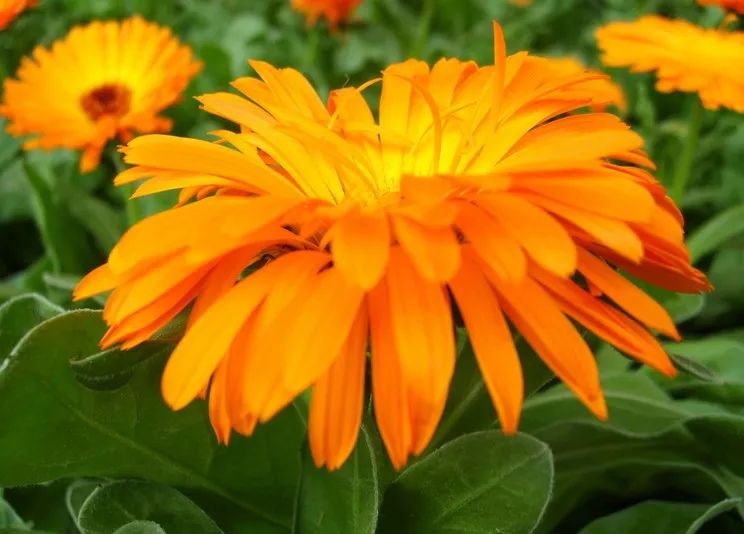
According to the Huangdi Neijing, the five movements of qi, which are the six qi of Heaven, alternate and change, governing seasonal variations and following a specific order. If they do not follow a specific order and exhibit abnormal operations, evil qi will arise, leading to disasters for all things. If they operate normally according to the specific order, it is righteous qi, and all things will develop normally.
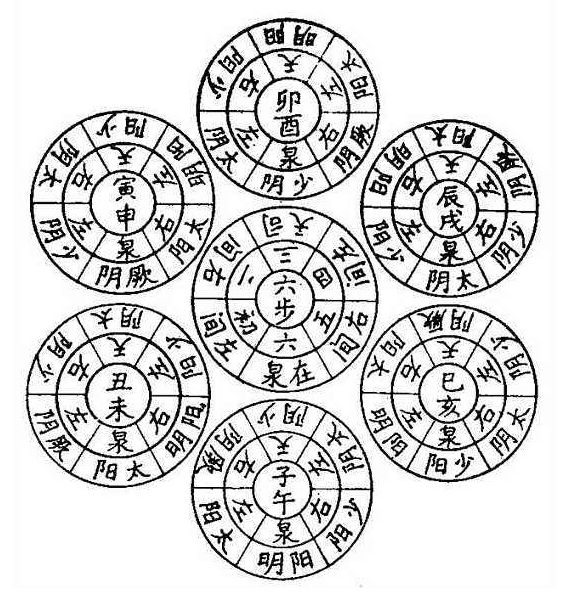
The theory of qi was proposed in the Huangdi Neijing, formally known as the Five Movements and Six Qi. The five movements are predicted according to the heavenly stems of the year, while the six qi are predicted according to the earthly branches of the year. The theory of movements and qi is a creative wisdom of the Chinese concept of the unity of Heaven and humanity, revealing the close relationship between the universe and human life.
For the specific calculation of the annual qi, one must first establish the heavenly stem of the year to determine the annual movement, and then based on the earthly branch of the year, clarify the qi of the year and the operational laws of the five movements (metal, wood, water, fire, earth) and the six qi (cold, heat, dampness, dryness, wind, fire). In this way, the laws of change in Heaven and Earth can be revealed, allowing people to adjust their bodies according to the laws of nature.

The Five Movements are the Concrete Manifestation of Yin and Yang
The Five Movements divide the year into five stages, predicting the climatic characteristics of each stage. These five stages correspond to the five seasons: spring, summer, long summer, autumn, and winter. The Five Movements begin from the Winter Solstice, with each movement lasting seventy-three days and five ke, totaling three hundred sixty-five days and twenty-five ke.
The Five Movements are further divided into main movements and guest movements. The main movement refers to the consistent qi of each of the five stages, which remains the same year after year, cycling continuously. The main movements are: first movement wood, second movement fire, third movement earth, fourth movement metal, and fifth movement water, roughly corresponding to the climatic characteristics of spring, summer, long summer, autumn, and winter. Although the general pattern is consistent year after year, each year’s climate has its unique characteristics, which can be deduced from the heavenly stems of that year, known as guest movements.
The guest movement, as the name suggests, is like a guest, being fluid. Like the main movements, the guest movements are also divided into five steps, but the difference is that the five steps of the main movements are fixed and unchanging, while the guest movements are subject to change. So, is there a way to predict them? Yes.
The method for predicting guest movements is based on the annual movement as the initial movement.
First step movement, then arranged according to the principle of mutual generation of the five elements, changing year by year, with a ten-year cycle. For example, in a Ren year, “in the year of Ding Ren, the wood movement is predominant”. Since the Ren year’s movement is wood, which is excessive, the first step movement of that year is also wood, indicating an excess of wood; the second step movement is insufficient fire; the third step movement is excessive earth; the fourth step movement is insufficient metal; and the fifth step movement is excessive water. Other years can be deduced similarly. According to the theory of the five sounds, the first step movement is Tai Jiao, the second step movement is Shao Zhi, the third step movement is Tai Gong, the fourth step movement is Shao Shang, and the fifth step movement is Tai Yu. Tai Jiao, Shao Zhi, Tai Gong, Shao Shang, and Tai Yu refer to the five steps of guest movements: the first movement is Tai Jiao, the second movement is Shao Zhi, the third movement is Tai Gong, and so on. The five stages are arranged in the order of mutual generation of the five elements, with the five stages being Jiao, Zhi, Gong, Shang, and Yu. If the first step is Tai Jiao, the second step is Shao Zhi, the third step is Tai Gong… If the first step is Shao Jiao, the second step is Tai Zhi, the third step is Shao Gong… This is the principle of mutual generation of the five elements.
The Six Qi: A Special Calendar Passed Down
The six qi is a special calendar that has nearly been lost, fortunately preserved in the Huangdi Neijing. Among them, the qi of Heaven governs the first half of the year, while the qi of the spring governs the second half. Each of the six stages of the year lasts over sixty days, specifically sixty days and eighty-seven ke. The six qi also begin from the Winter Solstice, with each of the four solar terms constituting a stage, four multiplied by six equals twenty-four solar terms, which perfectly corresponds to the 365 days of a year. The six stages of the year are: the first stage: from the Winter Solstice to the Spring Equinox (approximately January 21 to March 21); the second stage: from the Spring Equinox to the Minor Grain (approximately March 21 to May 21); the third stage: from the Minor Grain to the Major Heat (approximately May 21 to July 23); the fourth stage: from the Major Heat to the Autumn Equinox (approximately July 23 to September 23); the fifth stage: from the Autumn Equinox to the Minor Snow (approximately September 23 to November 23); the sixth stage: from the Minor Snow to the Winter Solstice (approximately November 23 to January 21).
The six stages of the year, or six qi, have specific characteristics. Generally, from the first stage to the sixth stage, they are: Jue Yin Wind Wood, Shao Yin Jun Fire, Shao Yang Xiang Fire, Tai Yin Wet Earth, Yang Ming Dry Metal, and Tai Yang Cold Water. This is the overall rule, which remains fixed every year. The first stage of any year is dominated by wind, the second and third stages by heat, the fourth stage by dampness, the fifth stage by dryness, and the sixth stage by cold, which is called the main qi.
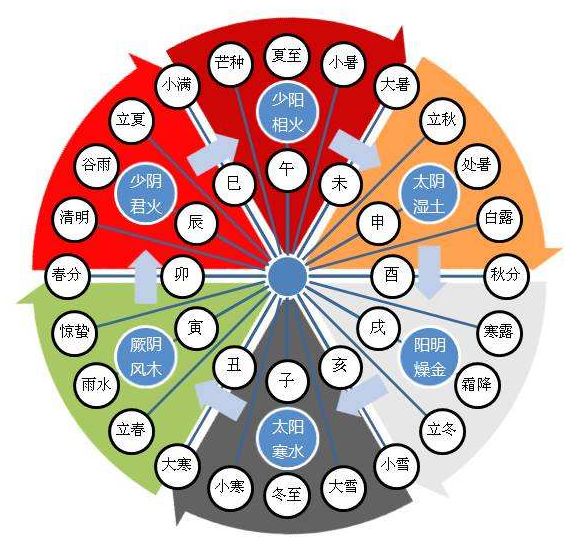
However, the actual situation is that the climate changes every year and cannot remain unchanged; there will be some special and abnormal changes, which are called guest qi. The main qi is like the host, while the guest qi is like a guest; the host is the master of the house, stable and unchanging; the guest is mobile and cannot remain still forever, coming and going frequently.
So, does the guest qi have rules? Yes. It changes according to the earthly branches of that year, and everyone must remember the mnemonic: “Si Hai Jue Yin Wind Wood, Zi Wu Shao Yin Jun Fire, Chou Wei Tai Yin Wet Earth, Yin Shen Shao Yang Xiang Fire, Mao You Yang Ming Dry Metal, Chen Xu Tai Yang Cold Water”. This mnemonic refers to the qi of Heaven, which governs the climate of the first half of the year. For example, in the year of Si or Hai, the Jue Yin Wind Wood governs Heaven, so in the year of 2019, which is the Ji Hai year, the first half of the year is dominated by wind and wood, with strong winds. The qi of Heaven not only governs the basic climate of the first half of the year but is also crucial for determining the climate of the third stage of the first half of the year, which is always fixed at the third qi of the main qi, thus governing the climate of the third stage.
The qi of Heaven is particularly important; once it is determined, the climatic characteristics of the other five stages can be known. What are the names of the other five stages? The first is called “in spring”, which corresponds to the third qi of Heaven; the second is called “in spring”, which corresponds to the sixth qi; the other four stages are called “intermediate qi”, which are located between the qi of Heaven and the qi of spring. There are two intermediate qi on the left and right of the qi of Heaven, and two intermediate qi on the left and right of the qi of spring. In total, there are four intermediate qi, plus the qi of Heaven and the qi of spring, making six qi in total, corresponding to six stages.
These six qi can be identified numerically, making it clear. The six qi from the first step to the sixth step are: 1. Left intermediate qi of spring, 2. Right intermediate qi of Heaven, 3. Qi of Heaven, 4. Left intermediate qi of Heaven, 5. Right intermediate qi of spring, 6. Qi of spring (left is the previous step, right is the next step).
As mentioned earlier, the unchanging order of the main qi from the first step to the sixth step is: 1. Jue Yin Wind Wood, 2. Shao Yin Jun Fire, 3. Shao Yang Xiang Fire, 4. Tai Yin Wet Earth, 5. Yang Ming Dry Metal, 6. Tai Yang Cold Water. The changing order of the guest qi from the first step to the sixth step is: 1. Jue Yin Wind Wood, 2. Shao Yin Jun Fire, 3. Tai Yin Wet Earth, 4. Shao Yang Xiang Fire, 5. Yang Ming Dry Metal, 6. Tai Yang Cold Water (only the positions of 3 and 4 are swapped, while the others remain the same).
Understanding the order of the guest qi makes it easy to deduce. As long as you know the qi of Heaven for that year, it is not necessary to remember the intermediate qi and the left and right intermediate qi; you can easily deduce the six steps of guest qi for that year. In fact, using a diagram, everything becomes clear.
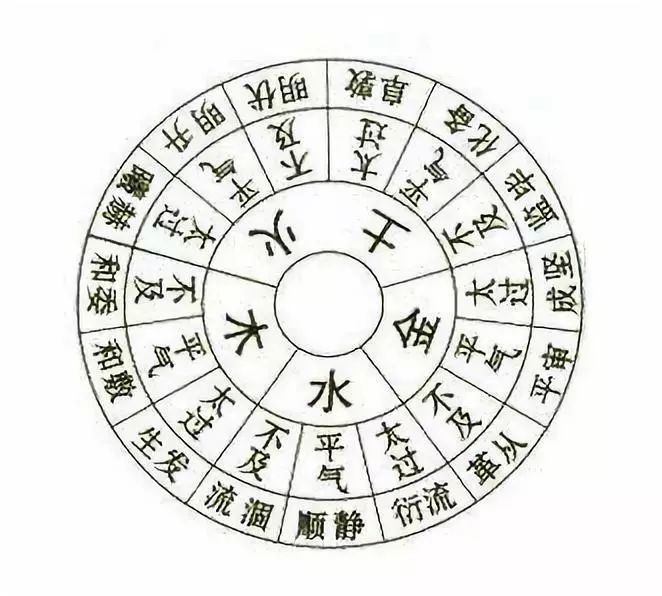
Health Preservation Also Requires Attention to “Qi”
According to the Huangdi Neijing, the five movements of qi, which are the six qi of Heaven, alternate and change, governing seasonal variations and following a specific order. If they do not follow a specific order and exhibit abnormal operations, evil qi will arise, leading to disasters for all things. If they operate normally according to the specific order, it is righteous qi, and all things will develop normally.
In the world between Heaven and Earth, health preservation also requires attention to “qi”:
First, evil qi causes illness, which is a form of disaster. The severity of the illness, whether the evil qi is strong or not, is related to “qi”. When the incoming qi aligns with the main seasonal qi, or when the guest qi aligns with the main qi, the illness will be mild; when the incoming qi does not align with the main seasonal qi, or when the guest qi does not align with the main qi, the illness will be severe.
Second, the “Theory of Qi Transformation” in the Huangdi Neijing discusses diseases caused by excessive or insufficient five movements, which are actually patterns of prevalent and susceptible diseases in specific years, beneficial for disease prevention and treatment.
Finally, the “Theory of the Five Constant Regulations” in the Huangdi Neijing states that treatment and medication must follow the laws of qi, with the core principles being: first, treat according to the symptoms and prescribe according to the syndrome; second, “grains, meat, fruits, and vegetables should be consumed in moderation, without excess, to avoid harming the original qi”; third, “do not replace transformation, do not violate the seasons, must nourish and harmonize, and wait for recovery”; meaning do not use human effort to replace the changes of qi, do not violate the seasonal cycles, and must adjust the spirit, calm the blood, and patiently wait for the recovery of righteous qi.
The Five Movements and Six Qi in Body Care
Gong Jiening

According to the TCM theory of the unity of Heaven and humanity, humans and the natural world are an organic whole, and abnormal seasonal changes in nature can directly or indirectly lead to imbalances of yin and yang in the body, resulting in disease. The Suwen states:“Five days are called the candidates, three candidates are called qi, six qi are called time, four seasons are called years.”“The sage does not treat existing diseases but prevents them; he does not treat chaos but prevents it.”Therefore, from the perspective of the unity of Heaven and humanity, based on the theory of the Five Movements and Six Qi, we can explore how to regulate and prevent diseases through diet and daily living.
(1) Nourishing from the Five Movements

1. Nourishing from the Annual Movement

The annual movement is divided into excessive and insufficient years. In sixty years, encountering yang stems (Jia, Bing, Wu, Geng, Ren) indicates an excessive year, while encountering yin stems (Yi, Ding, Ji, Xin, Gui) indicates an insufficient year.
Regarding the climatic changes in excessive and insufficient years, the Suwen states:
“In years of excessive wood, wind qi prevails, and the spleen is affected… In years of excessive fire, heat qi prevails, and the lung is affected… In years of excessive earth, damp qi prevails, and the kidney is affected… In years of excessive metal, dry qi prevails, and the liver is affected… In years of excessive water, cold qi prevails, and the heart is affected… In years of insufficient wood, dryness prevails… In years of insufficient fire, cold prevails… In years of insufficient earth, wind prevails… In years of insufficient metal, heat prevails… In years of insufficient water, dampness prevails.””
In years of excessive movement
 In years of excessive wood movement, wind qi prevails, so precautions should be taken against wind evil to avoid harm to the body. Wind is the leader of all diseases and can combine with cold, dampness, and heat to cause illness. Therefore, in years of excessive wood movement, attention should be paid to preventing wind. From the perspective of the five elements, wood overcomes earth, so the spleen is affected. TCM’s preventive approach states, “When liver disease is seen, it is known that the liver transmits to the spleen, so the spleen should be strengthened”; thus, care for the spleen and stomach should be prioritized, and foods that strengthen the spleen and stomach, such as yam and lentils, should be consumed.In years of excessive fire movement, heat qi prevails, so precautions should be taken to prevent damage from heat evil, avoiding excessive exposure to hot environments, and special attention should be paid to heat prevention. Heat qi prevails, and the lung is affected, so care for the lung should also be prioritized, as the lung is a delicate organ, and heat evil can easily harm lung yin. Therefore, lung yin protection should be emphasized, and lung diseases are likely to occur during this year, so preventive measures should be taken.In years of excessive earth movement, there is more rain and dampness, so precautions should be taken to prevent damp evil. Due to the sticky nature of dampness, diseases this year may have prolonged courses and be difficult to cure. Therefore, attention should be paid to eliminating damp evil. Dampness prevails, and the kidney is affected; excessive dampness can hinder the spleen, preventing it from controlling water flow to the kidney. Therefore, care for the kidney should be prioritized, and kidney yang should be protected, as yang qi can promote the movement of fluids.In years of excessive metal movement, dry qi prevails, so precautions should be taken to prevent damage from dryness. Dryness can harm body fluids, leading to dry skin, brittle hair, and other diseases caused by fluid damage. Dryness can also harm the lung, so lung diseases are likely to occur this year. Therefore, nourishing and hydrating foods should be used to alleviate dryness. Excessive metal movement overcomes wood, so liver diseases may also be prevalent; the liver governs growth, so care should be taken to prevent liver qi stagnation, and foods that soothe the liver and regulate qi should be consumed.In years of excessive water movement, cold qi prevails, and the climate is relatively cold, so precautions should be taken against cold evil. Cold is constrictive and can easily harm yang qi, so attention should be paid to dispelling cold evil and warming and supplementing yang qi. Water overcomes fire, so cold evil can harm heart fire; those with pre-existing heart conditions should pay special attention to care.In years of insufficient movement
In years of excessive wood movement, wind qi prevails, so precautions should be taken against wind evil to avoid harm to the body. Wind is the leader of all diseases and can combine with cold, dampness, and heat to cause illness. Therefore, in years of excessive wood movement, attention should be paid to preventing wind. From the perspective of the five elements, wood overcomes earth, so the spleen is affected. TCM’s preventive approach states, “When liver disease is seen, it is known that the liver transmits to the spleen, so the spleen should be strengthened”; thus, care for the spleen and stomach should be prioritized, and foods that strengthen the spleen and stomach, such as yam and lentils, should be consumed.In years of excessive fire movement, heat qi prevails, so precautions should be taken to prevent damage from heat evil, avoiding excessive exposure to hot environments, and special attention should be paid to heat prevention. Heat qi prevails, and the lung is affected, so care for the lung should also be prioritized, as the lung is a delicate organ, and heat evil can easily harm lung yin. Therefore, lung yin protection should be emphasized, and lung diseases are likely to occur during this year, so preventive measures should be taken.In years of excessive earth movement, there is more rain and dampness, so precautions should be taken to prevent damp evil. Due to the sticky nature of dampness, diseases this year may have prolonged courses and be difficult to cure. Therefore, attention should be paid to eliminating damp evil. Dampness prevails, and the kidney is affected; excessive dampness can hinder the spleen, preventing it from controlling water flow to the kidney. Therefore, care for the kidney should be prioritized, and kidney yang should be protected, as yang qi can promote the movement of fluids.In years of excessive metal movement, dry qi prevails, so precautions should be taken to prevent damage from dryness. Dryness can harm body fluids, leading to dry skin, brittle hair, and other diseases caused by fluid damage. Dryness can also harm the lung, so lung diseases are likely to occur this year. Therefore, nourishing and hydrating foods should be used to alleviate dryness. Excessive metal movement overcomes wood, so liver diseases may also be prevalent; the liver governs growth, so care should be taken to prevent liver qi stagnation, and foods that soothe the liver and regulate qi should be consumed.In years of excessive water movement, cold qi prevails, and the climate is relatively cold, so precautions should be taken against cold evil. Cold is constrictive and can easily harm yang qi, so attention should be paid to dispelling cold evil and warming and supplementing yang qi. Water overcomes fire, so cold evil can harm heart fire; those with pre-existing heart conditions should pay special attention to care.In years of insufficient movement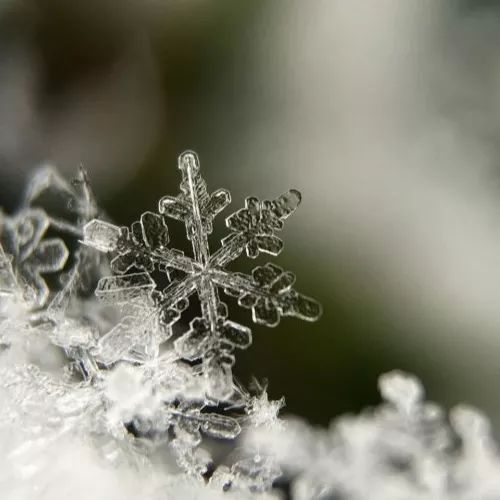
 In years of insufficient wood movement, metal overcomes wood, leading to dryness. Therefore, dryness prevails this year, and precautions should be taken to prevent damage from dryness. Dryness can harm body fluids, leading to dry skin, brittle hair, and other diseases caused by fluid damage. Dryness can also harm the lung, so lung diseases are likely to occur this year.In years of insufficient fire movement, water overcomes fire, leading to cold. Therefore, cold prevails this year, and precautions should be taken against cold evil. Cold is constrictive and can easily harm yang qi, so attention should be paid to dispelling cold evil and warming and supplementing yang qi.In years of insufficient earth movement, wood overcomes earth, leading to wind. Therefore, wind prevails this year, and precautions should be taken to avoid wind evil to prevent harm to the body. Wind is the leader of all diseases and can combine with cold, dampness, and heat to cause illness, so attention should be paid to preventing wind in years of insufficient earth movement.In years of insufficient metal movement, fire overcomes metal, leading to heat. Therefore, heat prevails this year, and precautions should be taken to prevent damage from heat evil, avoiding excessive exposure to hot environments, and special attention should be paid to heat prevention.In years of insufficient water movement, earth overcomes water, leading to dampness. Therefore, dampness prevails this year, and precautions should be taken to prevent damage from damp evil. Due to the sticky nature of dampness, diseases this year may have prolonged courses and be difficult to cure. Therefore, attention should be paid to eliminating damp evil.
In years of insufficient wood movement, metal overcomes wood, leading to dryness. Therefore, dryness prevails this year, and precautions should be taken to prevent damage from dryness. Dryness can harm body fluids, leading to dry skin, brittle hair, and other diseases caused by fluid damage. Dryness can also harm the lung, so lung diseases are likely to occur this year.In years of insufficient fire movement, water overcomes fire, leading to cold. Therefore, cold prevails this year, and precautions should be taken against cold evil. Cold is constrictive and can easily harm yang qi, so attention should be paid to dispelling cold evil and warming and supplementing yang qi.In years of insufficient earth movement, wood overcomes earth, leading to wind. Therefore, wind prevails this year, and precautions should be taken to avoid wind evil to prevent harm to the body. Wind is the leader of all diseases and can combine with cold, dampness, and heat to cause illness, so attention should be paid to preventing wind in years of insufficient earth movement.In years of insufficient metal movement, fire overcomes metal, leading to heat. Therefore, heat prevails this year, and precautions should be taken to prevent damage from heat evil, avoiding excessive exposure to hot environments, and special attention should be paid to heat prevention.In years of insufficient water movement, earth overcomes water, leading to dampness. Therefore, dampness prevails this year, and precautions should be taken to prevent damage from damp evil. Due to the sticky nature of dampness, diseases this year may have prolonged courses and be difficult to cure. Therefore, attention should be paid to eliminating damp evil.

2. Nourishing from the Main Movement


The main movement refers to the regular climatic changes of the five seasonal qi throughout the year. It is determined based on the climatic changes of each season and their five-element properties. Each movement corresponds to one season, starting with the wood movement and ending with the water movement, remaining unchanged year after year. The five movements correspond to the five seasons: wood for the initial movement in spring, fire for the second movement in summer, earth for the third movement in long summer, metal for the fourth movement in autumn, and water for the final movement in winter.
The initial movement of wind wood qi is at its peak, as the wind comes from the east, the weather gradually warms, and all things begin to grow, corresponding to the liver. The Suwen states: “When the wind qi is strong, wood prevails, and dampness harms the spleen.” This indicates that excessive wind wood qi can easily lead to an overactive liver affecting the spleen. Therefore, during the initial movement, care for the spleen and stomach should be prioritized. Additionally, the “Eight Notes of Zunsheng” mentions early spring: “As the spring sun rises, all things begin to sprout, during the second month, the weather fluctuates between cold and hot… The weather is inconsistent… Cold winds can easily harm the pores.” It also states: “Do not remove cotton clothing too soon; the elderly have weak qi, and their bones are frail, making them susceptible to wind and cold. It is advisable to keep warm and wear layered clothing, gradually reducing layers, rather than exposing oneself too quickly.” This indicates that during this period, the wind wood qi is at a turning point where yin recedes and yang rises, and it is not advisable to remove cotton clothing too early to prevent invasion by wind and cold evils. The second movement is Shao Yin Jun Fire, starting from the Qingming solar term, passing through Guyu, Lixia, and Xiaoman. During this period, all things grow, and the yang qi within the human body gradually increases, corresponding to the heart. After Qingming, the southern regions experience more rain and rising temperatures, while the northern regions are primarily warm and dry. In terms of diet, it is advisable to avoid overly warm foods, as they can easily lead to heat-related diseases. Additionally, the downward movement of fire qi can restrain lung qi, making it easy for fire to harm the lung; thus, during the second movement, care should be taken to clear heat and moisten the lung.
The second movement is Shao Yin Jun Fire, starting from the Qingming solar term, passing through Guyu, Lixia, and Xiaoman. During this period, all things grow, and the yang qi within the human body gradually increases, corresponding to the heart. After Qingming, the southern regions experience more rain and rising temperatures, while the northern regions are primarily warm and dry. In terms of diet, it is advisable to avoid overly warm foods, as they can easily lead to heat-related diseases. Additionally, the downward movement of fire qi can restrain lung qi, making it easy for fire to harm the lung; thus, during the second movement, care should be taken to clear heat and moisten the lung.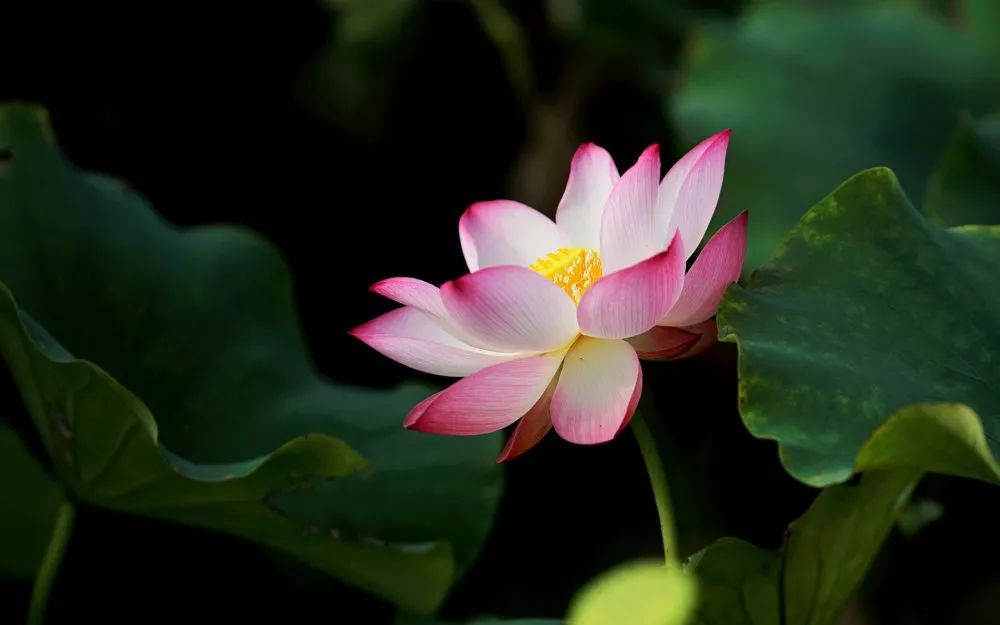 The third movement is Shao Yang Xiang Fire, starting from Mangzhong, passing through Xiazhi, Xiaoshu, and Dashu. During this time, the weather is hot and rainy. In the southern regions, the Meiyu (plum rain) season occurs around Mangzhong. The “Compendium of Materia Medica” states: “Meiyu can cause mold to grow on clothing, leading to black mold.” During the Meiyu season, due to continuous rain, the humidity is high, and clothing can easily develop mold. The human body is also affected by the dampness of the season. As stated in the “Essential Prescriptions of the Golden Chamber”: “Wearing damp clothing or sweaty clothing for too long can lead to sores and wind itch.” Additionally, heat is a major characteristic of the third movement. The “Chronicles of the Capital” states: “During the summer solstice, families in the capital eat cold noodles, which is a local delicacy.” Eating cold noodles can stimulate appetite and cool down. Therefore, during the third movement, it is advisable to maintain a light diet and avoid rich and heavy foods while also preventing heatstroke.
The third movement is Shao Yang Xiang Fire, starting from Mangzhong, passing through Xiazhi, Xiaoshu, and Dashu. During this time, the weather is hot and rainy. In the southern regions, the Meiyu (plum rain) season occurs around Mangzhong. The “Compendium of Materia Medica” states: “Meiyu can cause mold to grow on clothing, leading to black mold.” During the Meiyu season, due to continuous rain, the humidity is high, and clothing can easily develop mold. The human body is also affected by the dampness of the season. As stated in the “Essential Prescriptions of the Golden Chamber”: “Wearing damp clothing or sweaty clothing for too long can lead to sores and wind itch.” Additionally, heat is a major characteristic of the third movement. The “Chronicles of the Capital” states: “During the summer solstice, families in the capital eat cold noodles, which is a local delicacy.” Eating cold noodles can stimulate appetite and cool down. Therefore, during the third movement, it is advisable to maintain a light diet and avoid rich and heavy foods while also preventing heatstroke. The fourth movement is Tai Yin Wet Earth, occurring from the beginning of autumn to the autumn equinox, corresponding to the late summer and early autumn of each year, characterized by heavy humidity, corresponding to the spleen. The Suwen states: “All dampness and fullness belong to the spleen.” Dampness is a yin evil that can easily harm the body’s yang qi, leading to qi stagnation, resulting in water retention or diarrhea. During this stage, the body may experience external heat and internal cold; excessive cold foods should be avoided, as they can harm the spleen and stomach, leading to vomiting and diarrhea. Watermelon, mung bean soup, and dried plum with red beans are excellent thirst-quenching and cooling foods, but they should not be consumed cold. Protecting the spleen and stomach is the key to health preservation during the fourth movement.
The fourth movement is Tai Yin Wet Earth, occurring from the beginning of autumn to the autumn equinox, corresponding to the late summer and early autumn of each year, characterized by heavy humidity, corresponding to the spleen. The Suwen states: “All dampness and fullness belong to the spleen.” Dampness is a yin evil that can easily harm the body’s yang qi, leading to qi stagnation, resulting in water retention or diarrhea. During this stage, the body may experience external heat and internal cold; excessive cold foods should be avoided, as they can harm the spleen and stomach, leading to vomiting and diarrhea. Watermelon, mung bean soup, and dried plum with red beans are excellent thirst-quenching and cooling foods, but they should not be consumed cold. Protecting the spleen and stomach is the key to health preservation during the fourth movement. The fifth movement is Yang Ming Dry Metal, occurring from the cold dew to the minor snow, corresponding to the autumn and winter transition, characterized by dryness, corresponding to the lung. The characteristic is that “dryness prevails and leads to desiccation”; during this period, temperatures drop, and the weather becomes dry, with significant temperature differences between day and night, making it easy to cause lung-related diseases. Therefore, health preservation should focus on nourishing yin and moistening the lung, while also paying attention to adding clothing in a timely manner. Common ailments during this time include wheezing, vomiting, and coughing. Dietary therapy can include pears, lilies, and lotus root, which nourish yin and moisten the lung.
The fifth movement is Yang Ming Dry Metal, occurring from the cold dew to the minor snow, corresponding to the autumn and winter transition, characterized by dryness, corresponding to the lung. The characteristic is that “dryness prevails and leads to desiccation”; during this period, temperatures drop, and the weather becomes dry, with significant temperature differences between day and night, making it easy to cause lung-related diseases. Therefore, health preservation should focus on nourishing yin and moistening the lung, while also paying attention to adding clothing in a timely manner. Common ailments during this time include wheezing, vomiting, and coughing. Dietary therapy can include pears, lilies, and lotus root, which nourish yin and moisten the lung. The final movement is Tai Yang Cold Water, including the major snow, winter solstice, minor cold, and major cold, characterized by extreme cold, corresponding to the kidney. During this period, the weather is extremely cold, so precautions should be taken against cold and to protect yang qi. Foods should be chosen that are sweet and warm, with the effects of warming and supplementing the spleen and stomach, nourishing qi and blood, and dispelling cold. Additionally, during this period, vigorous exercise should be avoided, especially excessive sweating, as “sweat is the fluid of the heart”; excessive sweating can lead to the loss of qi and fluids, thereby harming heart yang.These principles are based on the characteristics of the main qi in the theory of movements and qi. In fact, the main qi of each year is also influenced by the guest qi of that year, so when discussing health preservation based on the annual qi, the interaction between guest qi and main qi must also be considered. Due to the complexity of guest qi changes, the related health preservation measures will not be elaborated here. This article is excerpted from “The Study of Seasonal Health Preservation in TCM”, published by the People’s Health Publishing House, edited by Gong Jiening.
The final movement is Tai Yang Cold Water, including the major snow, winter solstice, minor cold, and major cold, characterized by extreme cold, corresponding to the kidney. During this period, the weather is extremely cold, so precautions should be taken against cold and to protect yang qi. Foods should be chosen that are sweet and warm, with the effects of warming and supplementing the spleen and stomach, nourishing qi and blood, and dispelling cold. Additionally, during this period, vigorous exercise should be avoided, especially excessive sweating, as “sweat is the fluid of the heart”; excessive sweating can lead to the loss of qi and fluids, thereby harming heart yang.These principles are based on the characteristics of the main qi in the theory of movements and qi. In fact, the main qi of each year is also influenced by the guest qi of that year, so when discussing health preservation based on the annual qi, the interaction between guest qi and main qi must also be considered. Due to the complexity of guest qi changes, the related health preservation measures will not be elaborated here. This article is excerpted from “The Study of Seasonal Health Preservation in TCM”, published by the People’s Health Publishing House, edited by Gong Jiening.
Source: Sub-health Manual Therapy, Hanhai Yixue, Da Dao Jia Yuan, Ren Wei TCM
For neck, shoulder, waist, and leg pain, apply Hei Bai Tong patches.

